Morgan Mystery – The County Bridge
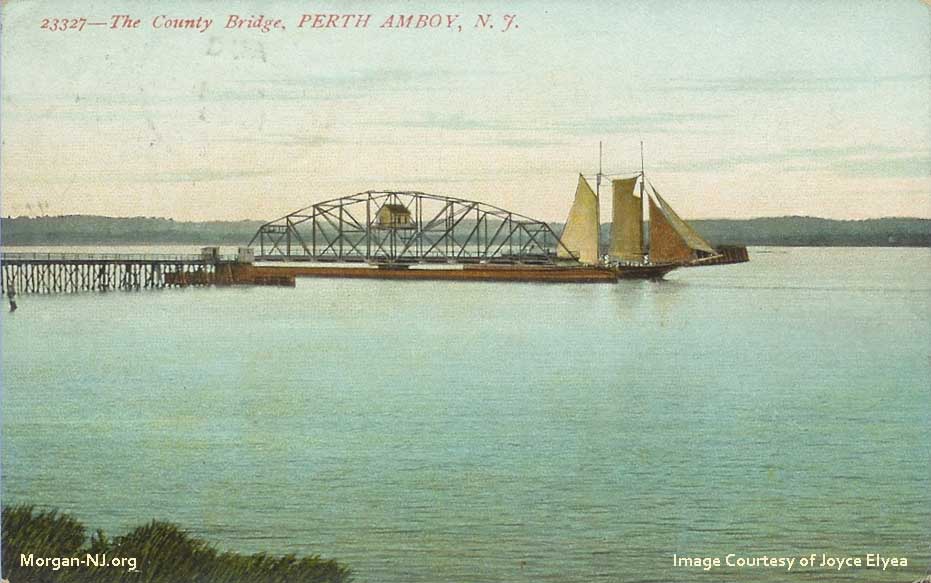
During my two decades in Morgan, there were three automobile bridges over the Raritan River near its mouth with Raritan Bay. The Parkway bridge cost something to ride on and was somewhat inconvenient to get to at the time. The ancient Victory Bridge was also kind of out of the way but made an interesting sound when driven on. Typically, the bridge to take over the Raritan River, when in a car, was the Edison Bridge. It was, after all, “Highway 9” and, even better, free.
While first reading about the 1918 Morgan based Gillespie Shell Loading Company explosions, the various newspapers would discuss how many of the citizens of South Amboy walked over the “County Bridge” in order to get out of the city and away from the horrific explosions which were happing to the south of South Amboy. The bridge was north. After finding out that the Victory Bridge, the oldest auto bridge across the Raritan in my time, wasn’t opened until 1926, the curiosity grew. What bridge did these frightened people cross that terrible weekend, what did it look like, and where was it actually located? I had never noticed the remains of any other bridge across the Raritan so it was another Morgan mystery!
Again, thanks to the generosity of Joyce Elyea, I caught my first glimpse of this long-forgotten pioneer bridge which once crossed the Raritan for 20 something years. Before we jump on the bridge, so to speak (or write), let’s first get an idea what transportation was like in the area in previous centuries.
In 1900, there were boats, there were trains and there were horses. I guess there were also shoes. Bicycles became popular in the 1890s but there was this thing known as winter in New Jersey which made bicycling seasonal at best. Street cars, better known as trolleys, were just about to become popular for a couple of decades but they were still a few years off. In 1900, there was one bridge across the Raritan River near its mouth. It was the railroad bridge from the 1870s.
Automobiles were still in their infancy.
When the Perth Amboy area was settled starting in 1683, the only way to get across the Raritan River to current day South Amboy was via boat – not that there were many reasons at the time to actually cross over to present day South Amboy. While there might have been discussions at the time about building a bridge across the half mile wide river, it’s doubtful that such discussions actually would have happened at that time. At that time, London had its famous London Bridge but that was only one fifth the length of what would be needed to cross the Raritan. London was also already a thousand years old and had a large population which made the bridge necessary. It is doubtful that any technology was known or available at that time which could traverse the half mile wide tidal Raritan River, much less a river which had ice flows during the winter.
There was ferry service between Perth Amboy and South Amboy, later called Redford’s (or Radford’s) Ferry which started sometime in the late 1600’s.
It wasn’t until the very beginning of the 20th Century however when a road bridge finally became a reality.
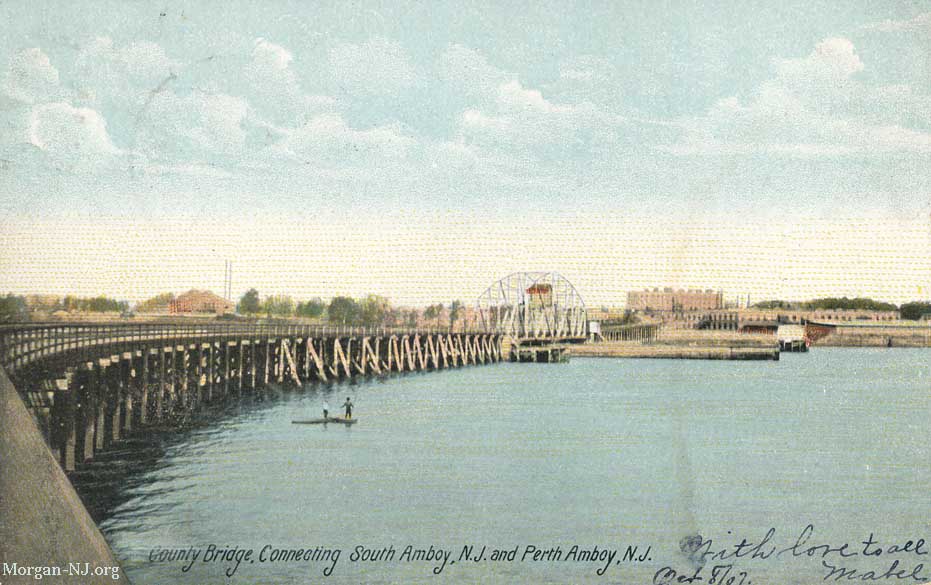
It’s difficult to determine exactly when construction the “County Bridge” over the Raritan River, located three quarters of a mile upstream of the original 1875 railroad bridge between Perth Amboy and South Amboy, actually began. One newspaper report implies 1902. We do know that it was already under construction as of August 6, 1903 per that issue of the Perth Amboy Evening News which reported, “The concrete is being laid at the rate of 150 cubic yards per day.”
It had the rather dull name of “County Bridge” because it was initiated and primarily funded by Middlesex County. The idea of naming bridges after people apparently didn’t start to become a thing until many years hence. $150,000 was provided by the Board of Chosen Freeholders of Middlesex County and a contract to build the bridge was awarded to the company Sanford & Harris.
In the subsequent next few years, a number of issues impeded the progress to complete and the open the County Bridge. The first issue was ice. I don’t ever recall seeing ice flows on the Raritan River during my time in Morgan but in the beginning part of the 20th Century, they were a thing. Global Warming, perhaps? During both the winters of March 1904 and January 1905, ice flows severely damaged the under-construction bridge – and in nearly the same place.
The January 19, 1905 Perth Amboy Evening News indicated, “The bridge was carried away for a space of seventy-five feet on the third of March last year.”
Apparently, there had been no ice guards built at the base of the bridge to protect against ice flows.
That same issue indicated that the new bridge was again severely damaged that January of 1905 morning by ice, “… the structure gave ‘way, pilings broke off and were pulled up, begin swept down the stream. The top of the bridge, while it had not been carried away this morning, was without support and sagged considerably leaning three or four feet out of line with the rest of the bridge and is momentarily expected to collapse.”
As if that wasn’t enough, another issue surrounding the completion of the bridge centered around who was responsible for building the Perth Amboy “approach” to the bridge. An “approach” is the roadway which “connects” the bridge to the land. There were discussions in December 1904 regarding whether or not the City of Perth Amboy should build an “approach” to the “unfinished” bridge. Its unclear to this author what the whole kerfuffle was all about but it seemed to have something to do with county rights/responsibilities vs. city rights/responsibilities. I didn’t see a similar issue for the south side of the bridge which technically was located in Sayreville.
As the Friday, December 16, 1904 issue states: “Let us know who has got to build the approach and then let the work be done without further delay.”
Again, and as if the ice flows and the approaches issues weren’t enough, there was one other barrier to opening the bridge. The August 17, 1905 issue of the Perth Amboy Evening News identified someone named Charles A. Bloomfield, Chairman of the Manufacturers’ Committee, who accused the Middlesex County Board of Chosen Freeholders of “misusing the public’s money.”
This author again has to admit that I don’t actually understand what that issue was or what the manufacturers’ committee was. Seems kind of sketchy.
Ultimately however, the approach issue eventually got resolved. The December 7, 1905 edition of the Perth Amboy Evening News announced that a contract to construct Perth Amboy approach was awarded to Sanford & Harris, the builders of the bridge.
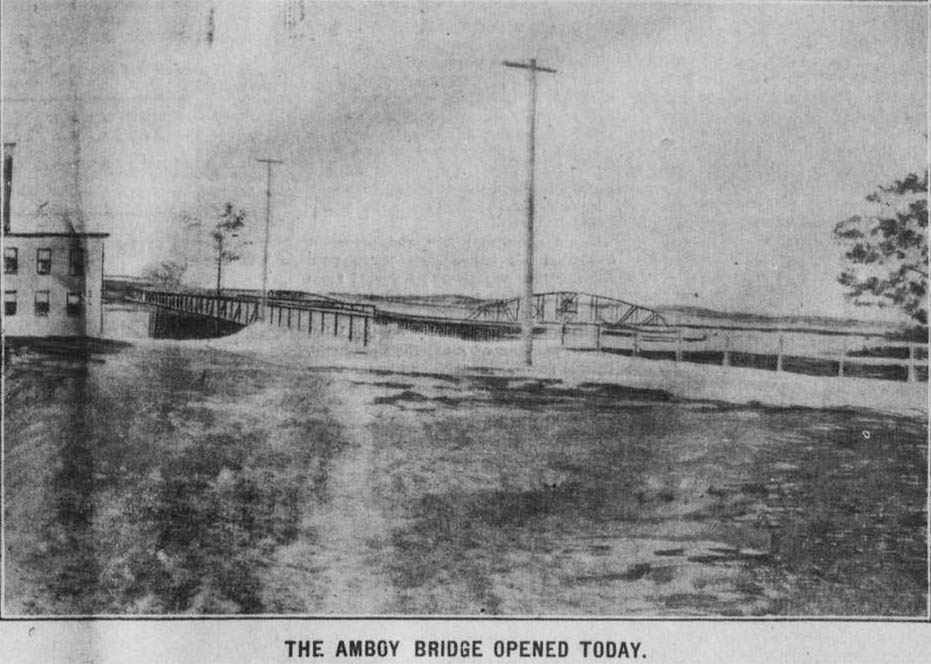
Finally, some six months later and after nearly four years of construction and however long of a delay because of Mr. Bloomfield, the County Bridge opened on June 19, 1906!
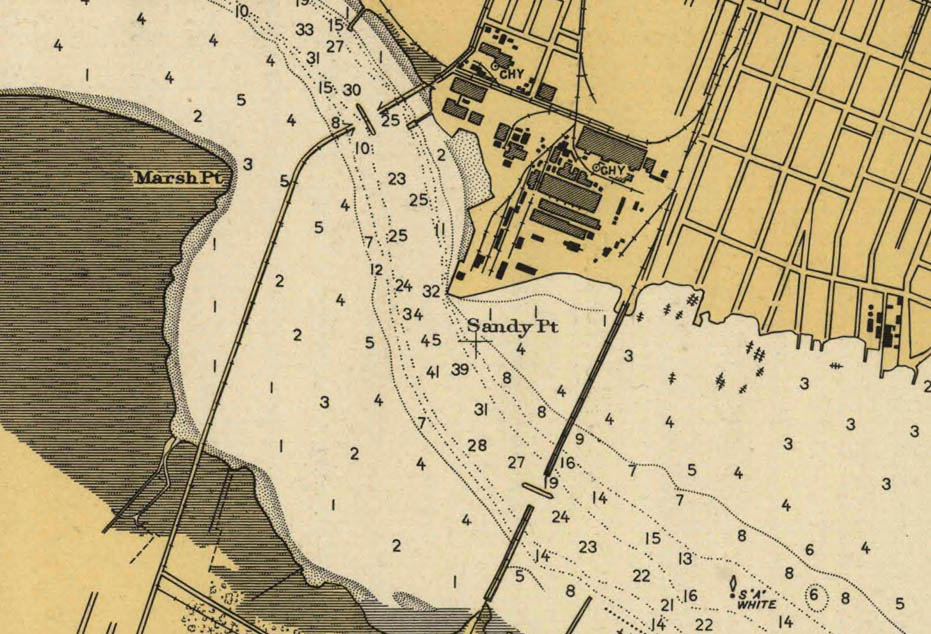
As can be seen in the 1924 map above, access to the county bridge from the Sayreville/South Amboy south side was via current day Scott Street. Drivers coming out of South Amboy to the bridge would have had to first to go through the famed, and still standing, “Hole in the Wall”. There was an unusually long approach (causeway?) from Scott Street leading up to the curve to the swing portion of the bridge. On the Perth Amboy side can be seen the relatively short – and once controversial – approach deck leading onto Sheridan Street. During the time of the bridge, there was a Chesebrough Manufacturing Company factory off of Sheridan Street where they manufactured Vaseline (U.S. Patent 127,568).
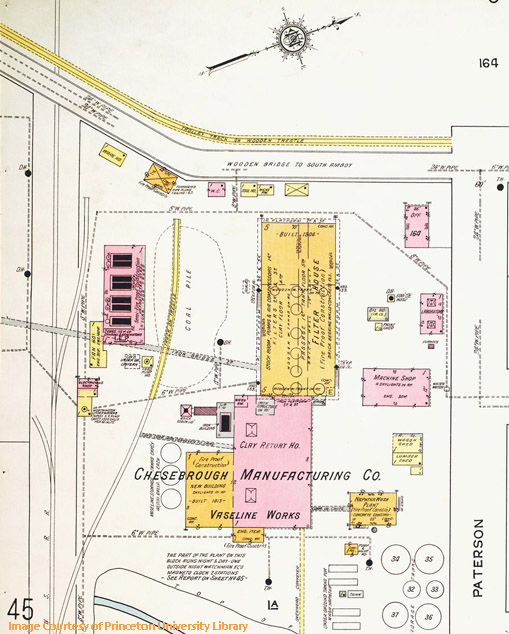
According to Bridgehunter.com (Bridge Inventory Number ID: BH 75211), the swing portion of the county bridge was 288.4 feet long and was of the type known as a Parker through truss swing bridge. The US Congressional Serial Set indicated the bridge had “a swing span with two draw openings each 109 feet wide with a vertical clearance when the draw is closed of 5.4 feet above the plane of mean high water.” The swing portion of the bridge was situated to accommodate the dredged Raritan River ship channel. Some accounts appear to indicate the first dredging of the river in this section may trace as far back as 1837. It was later dredged in 1923.
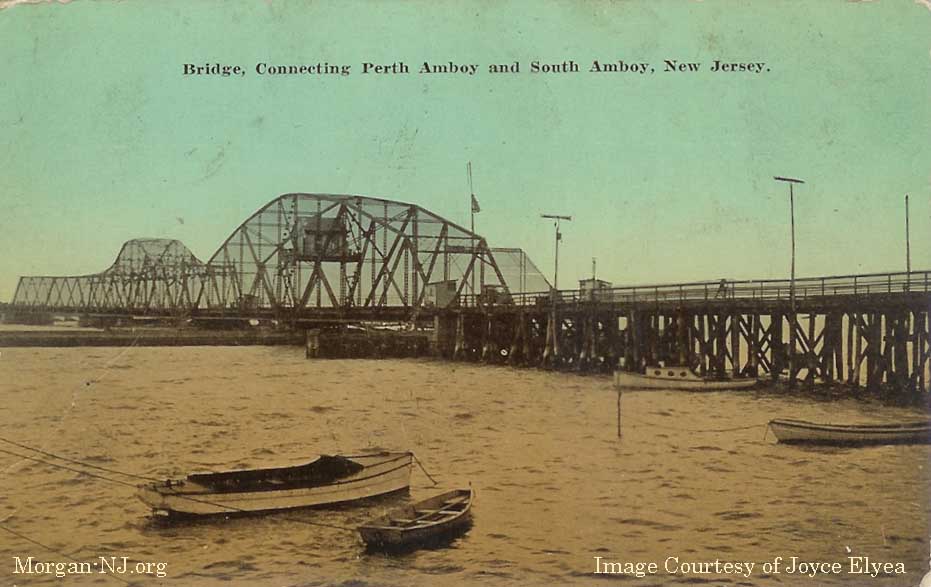
As can be seen on the picture post cards in this post, initially the bridge had the single Parker through truss swing section with a wooden road on both sides of it. Later post cards show another longer type of metal truss structure on the south side of the swing section. I have not yet found any explanation regarding the cause for this additional truss structure or when it was constructed. Perhaps it had to do with bridge integrity and ice flows or perhaps it was installed when the Jersey Central Traction Company added the trolley portions to the bridge (see below)?
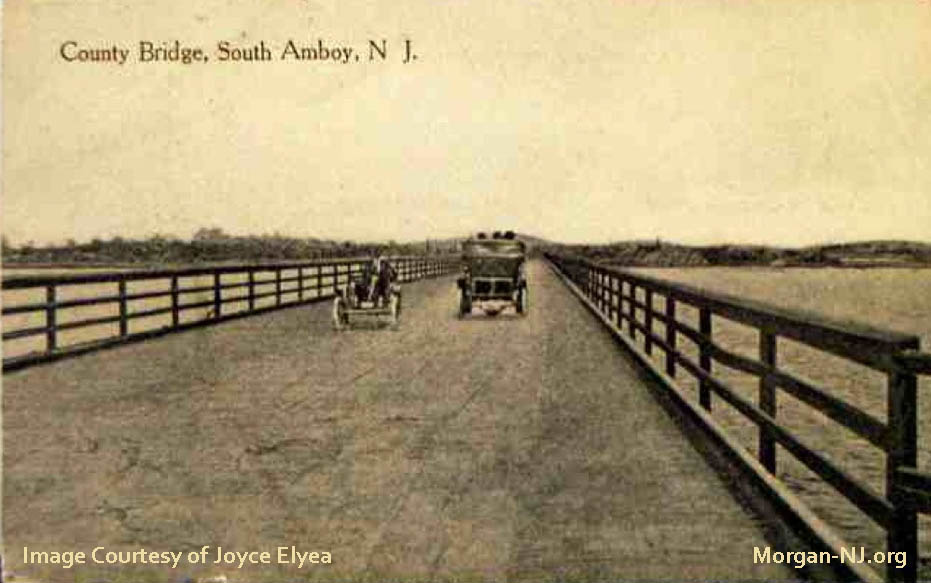
What would not have been clear to everyone in 1903 as construction of this bridge was beginning – which would have meant the design phase would have occurred earlier – was that a fundamental change in personal transportation was under way. Eighty years later, a similar type of paradigm change would occur with personal computers, 10 years after that another paradigm change was this thing called the internet, and 15 years after that was this thing called the smart phone. It is hard to know, especially at the “beginning” of a fundamental paradigm change, that a fundamental paradigm change is even occurring. The ramifications for this brand-new 1906 bridge across the Raritan River was that it was it wasn’t designed for cars, trucks, or trolleys so much as it was designed for pedestrians, horses and horse drawn carriages. In other words, just like the 1911 bridge constructed over Cheesequake Creek a few miles south of it, the County Bridge was obsolete even before it opened – but who knew?
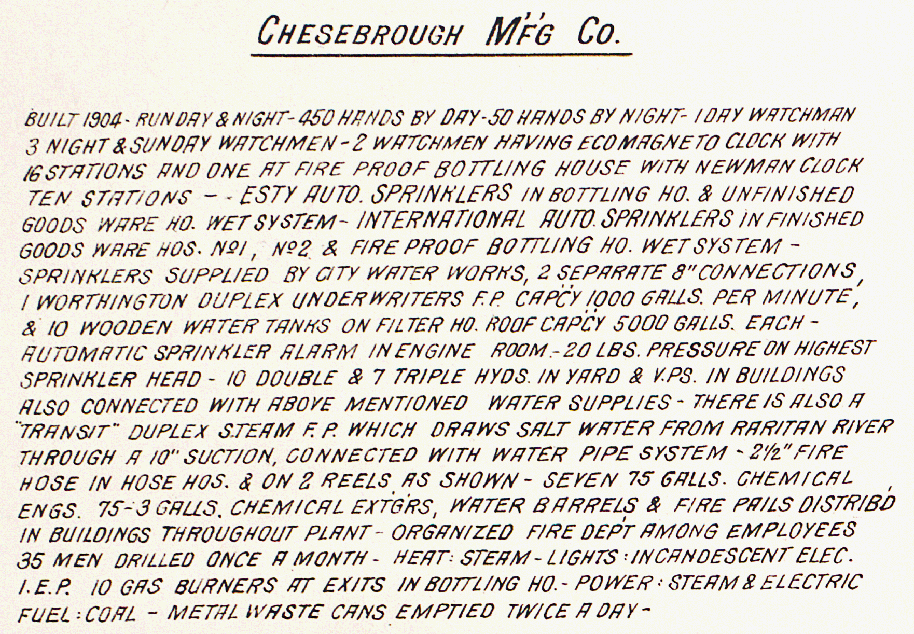
Let’s look at a little bit of the history of automobile manufacturing in the US for a little perspective regarding why. The Ford Motor Company became a corporation in June 1903 and didn’t start producing cars until the following month (right around when the concrete was being poured for the County Bridge). The bridge opened in 1906 and the Ford Model T, the uncontested best-selling motor vehicle in the early 20th Century (and still the #8 best-selling car of all time), didn’t even start rolling out of the factory until two years later in late September 1908. So, the amount of motorized vehicle traffic across the County Bridge for its first few years would not have been much.
Here is a table showing the number of car and truck motor vehicle registrations (not including busses) for all the United States between the years 1900 and 1920.
| Year | # of Cars | # of Trucks | Total |
| 1900 | 8,000 | 8,000 | |
| 1901 | 14,800 | 14,800 | |
| 1902 | 23,000 | 23,000 | |
| 1903 | 32,920 | 32,920 | |
| 1904 | 54,590 | 700 | 55,290 |
| 1905 | 77,400 | 1,400 | 78,800 |
| 1906 | 105,900 | 2,200 | 108,100 |
| 1907 | 140,300 | 2,900 | 143,200 |
| 1908 | 194,400 | 4,000 | 198,400 |
| 1909 | 305,950 | 6,050 | 312,000 |
| 1910 | 458,377 | 10,123 | 468,500 |
| 1911 | 618,727 | 20,773 | 639,500 |
| 1912 | 901,596 | 42,404 | 944,000 |
| 1913 | 1,190,393 | 67,667 | 1,258,060 |
| 1914 | 1,664,003 | 99,015 | 1,763,018 |
| 1915 | 2,332,426 | 158,506 | 2,490,932 |
| 1916 | 3,367,889 | 250,048 | 3,617,937 |
| 1917 | 4,727,468 | 391,057 | 5,118,525 |
| 1918 | 5,554,952 | 605,496 | 6,160,448 |
| 1919 | 6,679,133 | 897,755 | 7,576,888 |
| 1920 | 8,131,522 | 1,107,639 | 9,239,161 |
State Motor Vehicle Registrations, by Years, 1900 – 1920
Source: https://www.fhwa.dot.gov/ohim/summary95/mv200.pdf
A large percentage of these automobiles would have been in the New Jersey area as it was, even then, densely populated. Looking at the above table and adding the numbers of vehicles which were registered in the first 10 years of the 20th Century, there were well over 1 million cars on the roads of the US by 1910. Even just 1,000 crossings in an 8-hour day of the bridge would have a rate of two cars per minute.
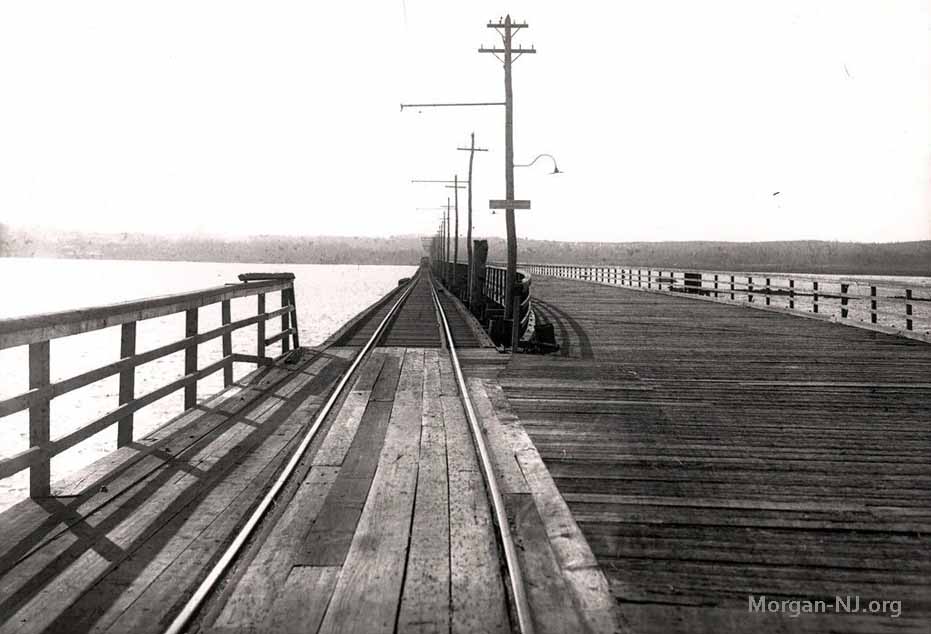
A major addition to the bridge came in 1910 when the Jersey Central Traction Company added their trolley tracks to the bridge. While one might think that the tracks would have been located in the middle of the road surface for the entire length of the bridge, because the bridge was an existing structure, the tracks had to be added to the sides. For the portion of the bridge on the south side of the swing bridge (the Sayreville/South Amboy side), a trestle was built on the east side of the roadway. For the portion on the north side of the swing (the Perth Amboy side), the track trestle was added on the west side. The only place the tracks were centered was on the swing portion of the bridge. Likely this was for weight balancing reasons but perhaps it was also a logical place to put the tracks if they needed to be on that side of the bridge when it landed in Perth Amboy. This author recalls once seeing an image of the tracks on the County Bridge in the swing section but doesn’t know where to find it now. If one of the readers finds such an image, please let us know where to find it.
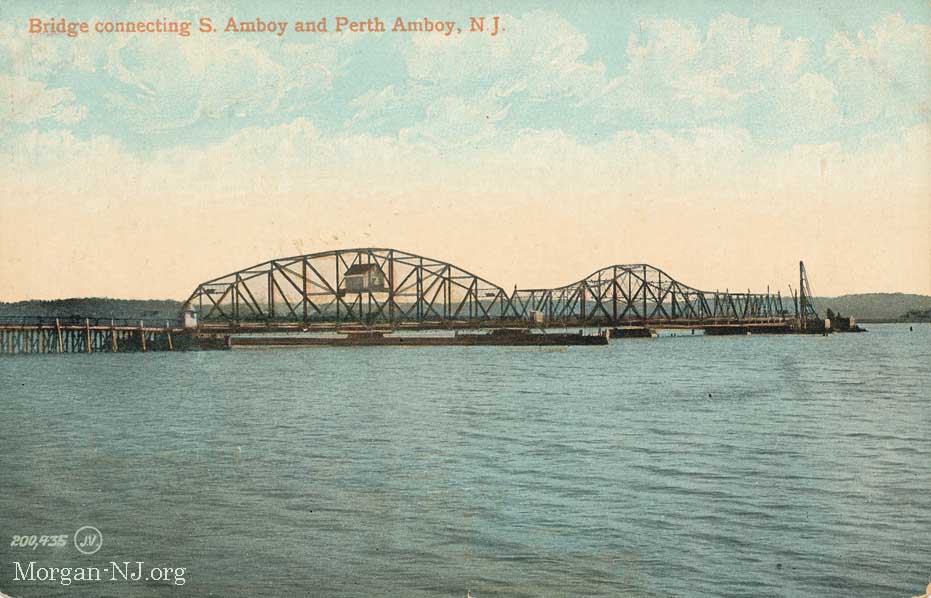
According to The History and Technology of the Edison Bridge & Driscoll Bridge, “Within a few years, it [the County Bridge] was inadequate to handle the traffic and the weight of increasingly larger trucks. Calls for a new bridge, which began in 1916, were answered ten years later by the Victory Bridge.”
Currently there are five automobile bridges and one train bridge spanning the Raritan River near its mouth to Raritan Bay. From west to east, they are the Alfred E. Driscoll Bridge (Garden State Parkway), Ellis S. Vieser Bridge (US Route 9 South), Thomas Edison Bridge (US Route 9 North), Victory Bridge #2 (NJ State Route 35), and the 1907 New Jersey Transit railroad bridge. Compare this to the turn of the 20th Century, there was only one bridge crossing the Raritan River near its mouth. That was the 1875 railroad bridge, the first bridge across the wide Raritan River near its mouth and the predecessor to the current NJ Transit railroad bridge. The “County Bridge” was the second bridge built across the mouth of the Raritan River. The third was the 1908 railroad replacement bridge. The fourth was the original Victory Bridge, opened in June 1926 which was the successor to the County Bridge.
Today, three of these four earliest bridges across the Raritan River near its mouth are totally gone and the 1908 railroad bridge’s days are now numbered as the ground breaking ceremony for construction of its replacement occurred on September 15, 2020. Few artifacts remain of the County Bridge which give away the presence of and the location of this essentially long-forgotten bridge. These are the portion of Scott Street on the river side of Main Street and possibly some pilings in the river.
This site’s main source of images of the bridge are via picture post cards with the majority of the coming from Joyce Elyea’s collection. Thank you yet again, Joyce!
This site has a very nice write up about the history of the bridge.
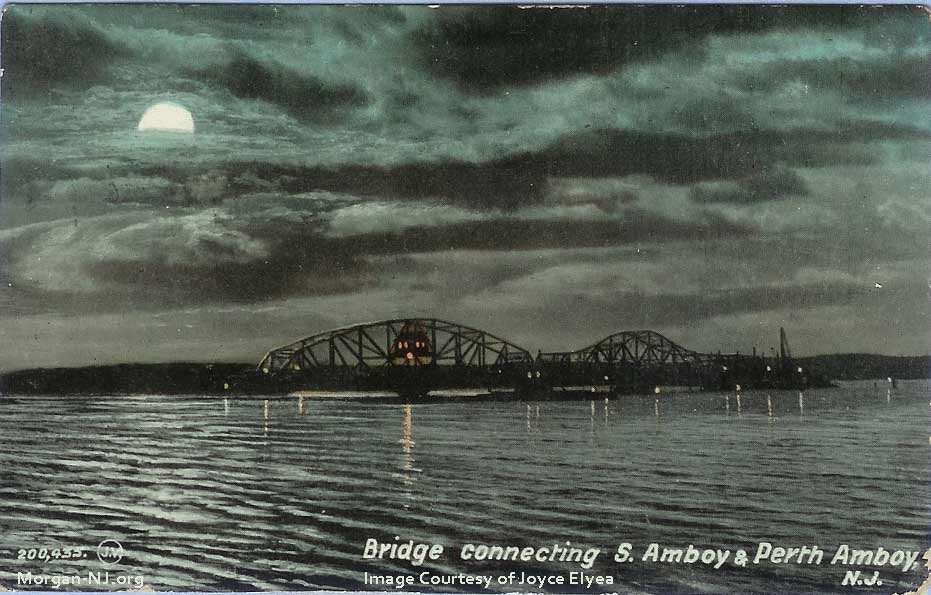
Originally posted November 14, 2020.